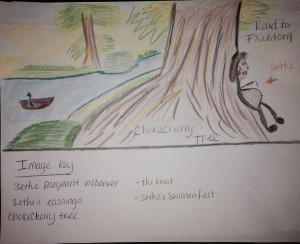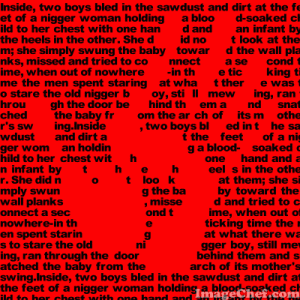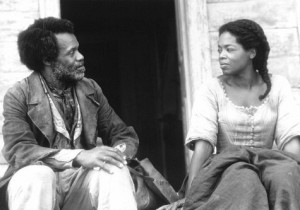In Beloved by Toni Morrison, the main character, Sethe, is living in Ohio with her daughter Denver. Sethe escaped the harsh brutalities as a slave, however, she continued to relive the bad memories she endured as a slave at Sweet Home. As Sethe lived her new life at 124, she tried not to mention the past to Denver, but it would always come up through the daily activities of her life or when Beloved, her deceased daughter, would ask her to retell stories of her life. As for Beloved, her ghost came back to ignite Sethe’s bad feelings of the past. Beloved caused Sethe to feel depressed for killing her and the attempted murder of her other children (175-179). However, the memory that really haunted Sethe’s conscious was when her milk was stolen (19-20). Therefore, if Sethe’s milk was not stolen, her husband, Halle, would have escaped with Sethe and their children and would not have been heart broken from witnessing his wife being violated; she would not have gotten post-traumatic stress from that harsh ordeal, which would eventually cause her to kill Beloved; have her children become fearful of her, and ultimately break up the family; lastly, Beloved’s ghost would not have returned to torment Sethe for killing her.
When Sethe’s milk was stolen, it devastated her. The memory that seared her conscious through her daily life was when “those boys [the nephews of the Schoolteacher] came in there and took her milk…they held her down and took it…Schoolteacher made one [of the boys] open up her back and when it closed it made a tree…they used cowhide on her and took her milk…they beat her while she was pregnant and they took her milk” (19-20). In this scene, it shows that while Sethe was a slave at Sweet Home, schoolteacher allowed her nephews to hold down Sethe to take her milk. As Sethe’s milk was being taken from her, schoolteacher was watching the whole thing. The milk that Sethe was going to use to nurse her baby girl, Beloved, was taken from her as if someone had raped her. Beloved and Sethe’s other children were already sent to Ohio and Sethe knew that when she arrived to Ohio she would have her milk ready to nurse Beloved, however, there was nothing to give to her child anymore.
The worse thing about that event was that her husband, Halle, “saw them boys [the nephews of the Schoolteacher] steal Sethe’s milk from her and let them keep on breathing air” (81). Halle watched the whole ordeal but he could not do anything about it. He could not defend Sethe or say one word because he was also a slave under the dominion of the schoolteacher. Halle saw that his role as a man had diminished and he no longer could protect his wife as a man was supposed to do, therefore, it broke Halle, affected his psyche, and caused him to smear butter all over his face (82-83). Halle, Sethe, and their children had planned to escape with Sixo and Paul D to Ohio, however, Halle disappeared after seeing Sethe’s milk being stolen (265). Once Halle was not in the picture, Sethe had to do everything by her self. While she was pregnant with Denver, Sethe had to send her children first to Ohio and then she had to escape by herself (190). Furthermore, while escaping she had to give birth to Denver, although Amy Denver, a white girl helped her, she was doing everything without Halle being there (190).
Secondly, the pain that Sethe acquired from her milk getting stolen caused her to get posttraumatic stress disorder. The hurt of the past overwhelm Sethe so much that she wanted to spare her children from experiencing the same ordeal, so, she swung “Denver toward the wall planks, missed and tried to connect a second time… while “Howard and Buglar lied open-eyed in the sawdust,” and the “third [Beloved] pumped blood down the dress of Sethe” (175-176). In this scene, it shows that Sethe attempts to kill Denver by hitting her against a wall after hurting her sons, Howard and Buglar, and cutting Beloved with a handsaw, so that it causes her blood to cover Sethe’s dress. Sethe could not deal with the violation of her milk being stolen, so, it gave her a reason to take the life of Beloved and attempt to kill her other children as a means of saving them from the harsh brutalities of slavery. Furthermore, when Sethe kills Beloved, she violently kills her in a way that defied the love one would expect a mother to have for her children. Sethe did not have to kill her daughter; she could have abandoned her children by not meeting with them in Ohio and going to a different state. However, Sethe thought that death was the only means to save her children. To Sethe, it was better for her children to die, then to live and end up facing the same ordeal she went through.
Next, in the event of Sethe killing Beloved, it caused her other children to be afraid of her (216 & 242). During Beloved’s funeral “neither Howard nor Buglar would let Sethe near them, not even to touch their hair” (216). They were afraid that Sethe would do the same thing to do them as she did to Beloved, so they eventually ran away (245). As for Denver, she continued to live with Sethe because “she loved her mother but she knew that Sethe killed one of her own daughters, and tender as she was with her,” Denver was always living in constant fear that “the thing that happened that made it all right for her mother to kill her sister could happen again,” so, she was always watching her mother’s every move, lest she be killed as well (242). Therefore, Sethe’s trauma effect all her children by causing them to separate from their mother and ultimately break up the family bond that was once there.
Thirdly, since Sethe’s milk was stolen and she killed Beloved as a means to save them from the harsh brutalities of slavery, Beloved’s ghost returned in Sethe’s life to torment her for causing her death. When Beloved first came to 124, Sethe takes her in and helps her to recover on her health without knowing that it was her daughter (62-65). Later, Sethe realize that it is her deceased daughter that had returned to her. At first, Beloved and Sethe was always together indulging themselves in fancy clothes and food (282), however, the mood in the home changed and arguments began (284).
“Beloved accused Sethe of leaving her behind…And Sethe cried, saying she never did, or meant to—that she had to get her children out, away, that she had the milk all the time and had the money too for the stone but not enough…Beloved was not interested. Sethe pleaded for forgiveness, counting, listing again and again her reasons: that Beloved was more important, meant more to her than her own life. That she would trade places any day. Give up her life, every minute and hour of it, to take back just one of Beloved’s tears” (284).
In this scene, Beloved’s intentions are brought to light when she starts arguing with Sethe about abandoning her in Ohio. Sethe pleads to Beloved that she would never abandon her and that she had the milk ready for her when she arrived to Ohio. Sethe pleads for forgiveness but Beloved does not want to hear it, instead Beloved accuses Sethe for leaving her and that her abandonment was on purpose because she really did not love her. Furthermore, because Beloved believes that she was abandoned in Ohio, she concludes that Sethe killed her because Sethe no longer wanted her anymore. This lead Beloved to become very disrespectful by slamming things around the house, eating most of the food in the house, throwing salt on the floor, and breaking a windowpane (285). As Beloved gained more weight, Sethe lost weight and became neglectful in taking care of her own self. Instead of combing her hair or washing her face, Sethe “sat in a chair licking her lips like a chastised child while Beloved ate up her life” (295). Finally, Beloved attempted to kill Sethe with an ice pick but failed at it and disappeared (309). Therefore, Beloved’s return to torment her mother was out of lack of information of not knowing that Sethe had been violated with her milk being stolen. Sethe was trying to get all her children to Ohio and in that process schoolteacher’s nephews violated her when they stole her milk.
In conclusion, Sethe’s milk getting stolen was the most pivotal scene in Beloved because it brought an aftermath of pain and grief that followed Sethe from Sweet Home to Ohio. First, Sethe’s milk getting stolen, made her husband, Halle, get depressed and disappear from Sethe when they were supposed to escape to Ohio together with their children. Second, Sethe was dealing with post-traumatic stress from her milk getting stolen, which caused her to kill Beloved and have her children fearful of her, and lastly, Beloved’s ghost returned from the dead to torment and take revenge on Sethe for killing her. All of these events could have been avoided and she could have had her whole family together at Ohio. Instead these events broke Sethe’s family apart and caused Sethe to live in constant remorse for the killing of her daughter, Beloved.
Works Cited
Morrison, Toni. Beloved. New York: Vintage Books, a division of Random House, Inc., 1987. Print.








